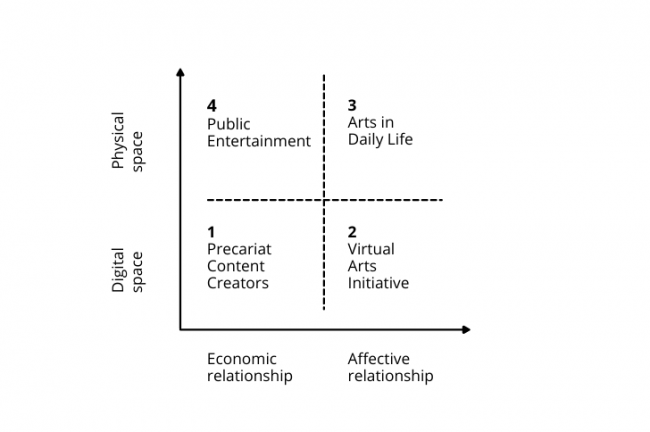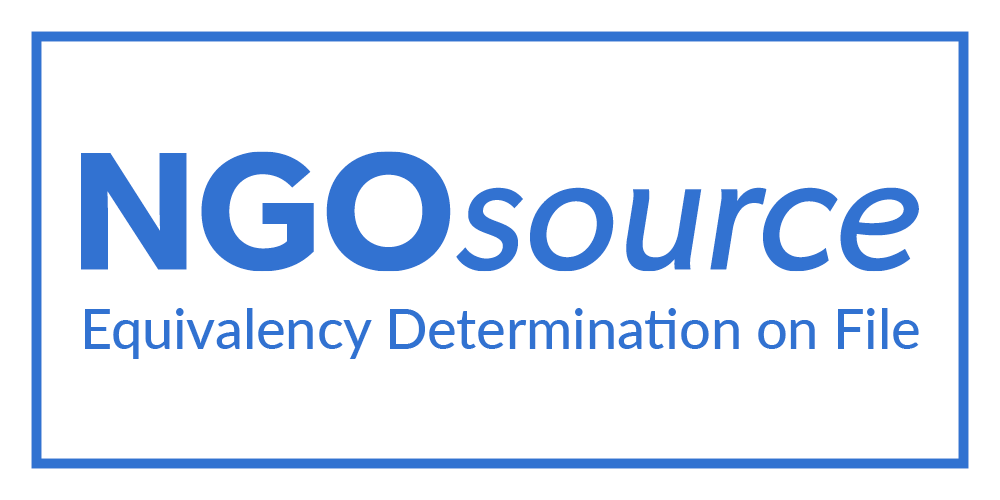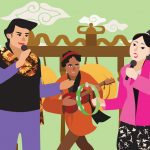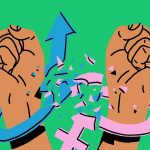Ratri Ninditya, Arts and Cultural Policy Research Coordinator, Koalisi Seni
The COVID-19 pandemic has undoubtedly changed the entire aspects of the world, where the arts ecosystem lies within. If we see the world as a network of rhizomes where humans, the environment, and basically everything are connected with and affect each other, then the pandemic can be regarded as an element which drastically breaks all these connections because it has the power that changes the very basic human needs: mobility and gathering.
In the realm of art, this crisis can easily surface the issues occurring within the arts ecosystem. As arts activists, we are so familiar with these issues: the fact that arts cannot be depended upon as a livelihood; the lack of access to opportunities to showcase, distribute, and develop works of arts for artists and the public alike; the unavailability of an integrated database of artists and their works; and the common perception that arts is just a form of entertainment and is not part of daily life which has social, economic, and environmental impacts. One can assume that arts and cultural activists remain invisible in an ecosystem which does not receive much attention. In the post-pandemic recovery efforts, arts is almost certainly the last on the list of priorities.
As a matter of fact, during the pandemic, the initiatives by arts collectives across many regions have instead made significant yet obvious impacts, by changing the relations between artists and the public as well as transforming the spaces for arts practices. Arts activists have established relationships with many different communities, including with the arts scene itself and with others beyond that in order to mobilize assistance, identify beneficiaries, utilize artworks or performances as a way to boost donations, appreciation to donors, and even as a means of crisis recovery itself. Some experts say that art is a proven way to help maintain mental health, especially during stay-at-home policy.
There have been countless arts communities which keep providing opportunities for arts activists to hold discussions, exchange ideas, and showcase their works. During the pandemic, the workspaces of several arts collectives were turned into food supplies storage and communal kitchens. In these new spaces, arts are no longer exclusive, but they merge into the community’s daily practices.
A democratic biopolitics, which is making its way from the bottom, is happening in the arts ecosystem, in which fear is replaced with social solidarity and the requirement to comply with the laws is turned into awareness of caring for each other. This tendency is consistent with Simon Mair’s idea of a society built on mutual aid. He emphasized that the best response to a crisis is produced at the community level. This scenario is one of his predictions about the post-pandemic world, where the protection of life becomes the main principle of the economy, and the state is not playing the major role.
In the future, if the state is still incapable of recovering after the crisis and ignores arts as well, this potential power will certainly fade away. This question is frequently asked among arts activists: artists can help the community, but who will help artists?
With the number of cases increasing daily, suppose we have to live with COVID-19 from now on. With that condition, let’s just imagine what will happen to art?
I imagine the future of the arts in four simple scenarios. In these four scenarios, the role of the state will be absent and replaced with the private sector and individuals. Parameters for these scenarios are taken from the two causes of concerns in today’s arts ecosystem: interaction space (virtual or physical) and relationship between actors (economic or affective).
In reality, these four scenarios are very likely to overlap with one another or happen simultaneously.
First Scenario: Precariat Content Creators
This scenario assumes that interaction between actors happens virtually with the economic motive becoming the main relation. In this scenario, creators or artists will be spending much of their time in front of screens, obsessing over creating sensational content every single day. Ironically, there is zero viewer because everyone has become a live stream artist. We will become alienated en masse, easily replaceable content creators with just a scroll away. Obsession about status will outweigh the compelling need to monetize performances. Many basic needs cannot be satisfied. Just like electricity bill, internet plan price will be rising as well as music and movie streaming platform prices. However, the top-charting artists will only receive small shares of the revenues. Female artists who are married and/or have children will be very likely to leave the industry. Domestic violence cases will be rising in number.
The precariat generation will come along, consisting of those who get stuck in a precarious situation, whose futures are not certainly getting better, and who go unnoticed despite their large number. Bad debt will rise, and artists are saddled with unpayable debts. If their content ever goes viral, their energy and creativity will be squeezed out of them by companies without being adequately rewarded. And the next thing they know, they will be forgotten again. The established arts institutions will be in private hands. They will offer arts classes that are more interesting than those provided through the public television, but with more expensive costs, so that only the upper class will be having access to them. Arts becomes exclusive and shallow as well as largely associated with profit-oriented institutions.
This whole precariat artists situation actually had happened long before the pandemic even started. The pandemic just exacerbates this uncertain situation since without any physical space, humans just become automata, deprived of their ability to develop relationships with others. There is no incentive to establish association because that affective motive can only be possible in a physical space. Thus, there is no protection for their status as artists/creative professionals.
Second Scenario: Virtual Arts Initiative
If the main interaction happens virtually and the relation is based on affective, then there will be several communities with relations developed before the pandemic. They will overcome the expensive internet connection problem by building their own internet infrastructure. Using different social media platforms, these communities expand their networks, mobilize resources, and engage themselves in hashtag activism as well as its networks at the global level. These communities are connected with one another on social media because they share similar ideas. Compelling slogans are the keys. The group’s identity and portfolio become very important when establishing networks.
However, artist’s sensitivity to the limitations and possibilities in the digital space will be very high. With vast access to information, they might find radical innovation, which will make their arts practices more eco-friendly (e.g., how to make their arts projects on the internet generate less heat) as well as ways to make their online interaction more meaningful and less exhausting. Not just a medium, digital technology becomes the main topic to be discussed and raised concerns about, to which the solutions are offered through works of art.
Artworks also play a major role in the initiative, such as serving as a means of recovery and an archive of collective memory. Associations and arts collectives will thrive at the local, national, and international levels. Nevertheless, as sociologists Ulrich Dolata and Jan-Felix Schrape put it, technology only plays a complementary role in a social movement, it cannot completely transform the social condition. The lack of opportunities for large gatherings in a physical space impedes the sense of belonging, relationship building between communities beyond the local scope, and bargaining power over other groups outside the communities.
Third Scenario: Arts in Daily Life
If interaction can only happen in a physical space and the relations between actors are predominantly affect-based, villages will be the most subsistent unit. Vigilance and mobility restrictions will make the community remain in these villages for isolation. We will see villages innovating in order to meet the basic needs of their communities through shared resources. Arts will be once again performed, for example, before and after a harvest festival or a traditional fishing ceremony. An alternative system of exchange will be implemented in these villages, such as barter, and arts can be one of the mediums of exchange. Devotees and artists lead the ceremonies and will be rewarded with crop and catch. The risk of this scenario includes a leadership system that is authoritative at the beginning since there is a compelling need to manage the community through the crisis recovery process. The development of arts will be consistent with global climate change because the arts practices will largely depend on nature.
Meanwhile, in the urban context, a participatory arts experiment is started in response to change. Artists can gather in a small group to discuss new aesthetics and engage themselves in the post-pandemic community recovery process. A radical arts initiative at the local level might thrive. Art might be a new method of learning for children who will have to study from home for a long time, whereas adults who are bored during the isolation might attempt to create their artwork again after years of not exercising their creativity.
Art as a means of recovery will be common both in rural and urban contexts. However, the impact will only be felt by a smaller scope of people, and each community has a different ability to recover. It also largely depends on the availability of natural resources and human resources across the regions. For example, the community who lives in a region where the natural resources are completely exploited by a mining company will not be able to promote their welfare, let alone any arts initiative. The arts are on the verge of going extinct among the communities who fail to recover.
Fourth Scenario: Public Entertainment
Interacting in a physical space with only economic motive forming the basis of relations between individuals will isolate artists in rented houses, and they will have a closer relationship with neighbors in order to sell their artistic skills. The limited internet access and the desire to establish physical interactions, which cannot be replaced by the internet, encourage people to entertain themselves by watching paid live performances by the local community or playing a collection of pirated MP3 tracks, collected before music streaming services become popular. Lounge singers, dangdut orchestras, and buskers will largely benefit from this system of exchange. Technicians’ expertise will also be utilized to help erect a small stage.
In order to entertain the public, most artists will only perform other artists’ works, which have been popular before, so there will only be a few new works produced. Visual artists might receive commissions to support small and medium-sized businesses, such as painting murals at coffee shops or decorating community’s stages. There will be some groups of creative workers at RT/RW (neighborhood and community units) level, who will be managing these small-scale paid performances. Art will continue to thrive as long as it can be monetized, suits the popular taste, and relies on the local market mechanism.
Those four post-pandemic scenarios can be laid out in these quadrants.
Even if these scenarios feel caricatural, we can imagine that out of these four scenarios, the potential biggest issue is when individuals get alienated amid the hubbub of virtual space with the economy-based principle of ecosystem (first scenario). On the other hand, the possibility of interacting in a physical space and affective relations between individuals may still allow the arts to thrive, albeit with limitations. Ideally, the combination of physical and virtual arts spaces as well as economic-based and non-economic-based relations should be considered in the post-pandemic arts dynamics.
Should COVID-19 never be eradicated, Martin Suryajaya’s concept of a society where everything is implemented at the smallest scale is making more sense. The arts dynamics will be most feasible at the community level in the form of mutual aid society, proposed by Simon Mair. However, in order to achieve that mutual part, artists need to be supported. The government’s role should be considered in realizing the potential of actors in the regional arts and supporting their survival as well as in strengthening the network of actors, encouraging exchange of ideas, natural resources, and cultures between regions, and ensuring every participating actor can thrive together. After all, the initiatives of arts collectives should be supported by the government to ensure that they can last longer. Furthermore, the ability of each region to recover varies.
While some efforts made by the government to promote the arts during the pandemic should be appreciated, they are not sufficient already. The main prerequisite that the government should meet first is the basic needs of artists to ensure their survival, acknowledge their status, and protect their artistic freedom.
Meanwhile, the forms of support for ensuring communities’ survival and broaden their reach include:
- Funding on community scale, for example, through a Village Fund program or the Cultural Trust Fund. The Cultural Trust Fund, which will be ready to be disbursed next year, can be aimed at the communities and collectives with innovations, i.e. those that are able to produce new arts practices in response to the post-pandemic vulnerability, whether by providing workshops, producing works of art, making criticisms, or writing reflections.
- Ensuring that internet access is distributed evenly and digital literacy materials can meet the needs of each community. The development of community-based internet network infrastructure in Ciptagelar is the good practice that should be followed by other regions. The infrastructure was made by constructing transmission towers and wireless connection infrastructure collectively. The towers transmit wireless internet signal to the local neighborhood that has not been reached by the commercial internet service. Since the connection is provided by the local internet gateway, the cost can be minimized. To cover the cost, internet vouchers are then independently sold by the community.
- Alternatively, the access to information can be provided through mass media and local communication networks. Public television stations have started to broadcast more arts and cultural content. TVRI has made Saturday and Sunday the days when cultural programs are exclusively broadcasted. One of the programs is Podbox, which focuses on the discussion on the history and movement of arts communities, such as music and literature. In the future, this space should be able to be accessed easily by any arts communities that are looking to showcase and exchange their ideas and artworks.
- The physical arts space, such as the performing arts center and cultural center, can be reopened by implementing special guidelines, specific to the region’s needs and challenges. The guidelines should be focused on the safety of the technicians and artists, and included in the event budget.
- Encouraging the private sector, established arts institutions, and philanthropists to support arts collectives and communities. One of the ways to do so is through the cultural endowment fund, which gathers funds from individuals, the private sector, and non-governmental organizations. Private companies may also gather funds for the cultural fund, similar to the mecenat system implemented in Japan.
- Continue to raise awareness of the impacts of the arts on the community, i.e. how arts practices can help preserve the environment, promote social cohesion, and increase the community’s economic activity. It can be implemented by providing arts a larger portion in the formal school curriculum.
The vibrant arts dynamics in Indonesia will open up a very wide opportunity in the future. One thing is for sure, the target of the policies should be aimed at regional dynamics. Larger cities should learn from many experiments conducted by the arts and cultural actors in the outermost and remote regions. Transformation of relations between individuals in the arts ecosystem should be considered holistically and regarded as more than just a financial transaction. As a result, the aspirations of a healthier arts ecosystem can be achieved as more than just economic resilience, but also as thoughtfulness and ability to reflect critically on the ever-changing life experience.
Hopefully, we are not heading toward a new normal because in reality, arts and culture constitute a dynamic rhizomatic network, while “normal” is a dead end that we have to avoid.





[…] Tulisan selengkapnya bisa diunggah di https://koalisiseni.or.id/membayangkan-ekosistem-seni-pascapandemi/ […]